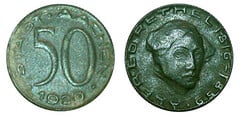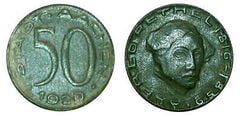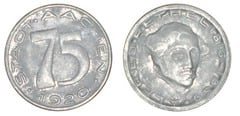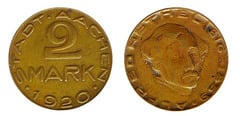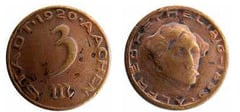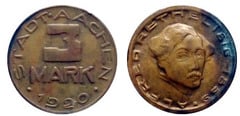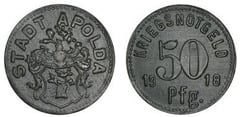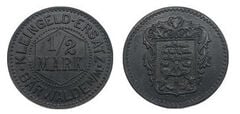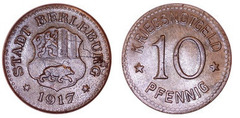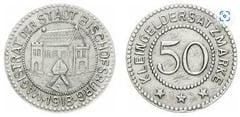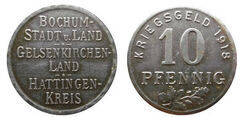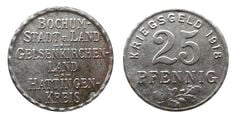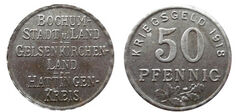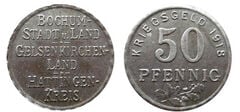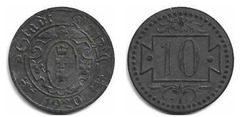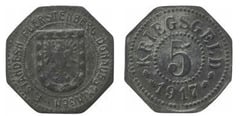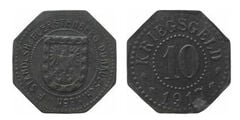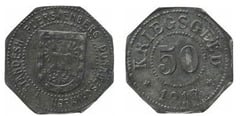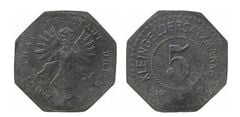Germany-Notgeld Coin List
Germany's recent monetary history is marked by significant events that have left an indelible mark on its numismatics. From the issuance of emergency coins known as Notgeld to the adoption of the euro, the German monetary system has undergone dramatic changes that reflect the country's turbulent history in the 20th century.
The Notgeld phenomenon
During and after World War I, Germany faced a severe shortage of circulating currency. In response, the Notgeld, or "emergency money," was issued by cities, businesses and even individuals. These pieces, often made from unconventional materials such as leather, silk or porcelain, became highly valued collectibles by numismatists due to their unique designs and historical significance.
From hyperinflation to the Deutsche Mark
The hyperinflation of 1923 marked another crucial chapter in German monetary history, with banknotes reaching astronomical denominations. After stabilization, the Reichsmark and later the Deutsche Mark were established as national currencies. The Deutsche Mark, introduced in 1948, became a symbol of the German economic miracle and remained in circulation until the adoption of the euro in 2002, leaving a rich numismatic legacy of coins and banknotes that reflect the recovery and prosperity of post-war Germany.
If you are a passionate collector, this catalog offers the possibility to create your own personal collection from this list. You can add your coins and generate a free PDF catalog from a complete database and our management tools.
Germany-Notgeld is a country that does not exist today. It is now part of the Germany old coins.
The most valuable and popular coins
The most valuable Germany-Notgeld coins and sought after by collectors according to Foronum statistics are the following:

The valuation of these coins list has been achieved through a meticulous algorithm that considers the current market, taking into account aspects such as material, weight, diameter, edge, year of mintage, mint of manufacture and the number of coins produced. Coins with limited mintages and in good condition are usually among the most valuable.
Coin Catalog
Germany-Notgeld | 50 pfennigs (City of Aachen-Prussian Rhine Province)
Germany-Notgeld | 50 pfennigs (City of Aachen-Prussian Rhine province)
Germany-Notgeld | 50 pfennigs (City of Aachen-Prussian Rhine Province)
Germany-Notgeld | 75 pfennigs (City of Aachen-Prussian Rhine province)
Germany-Notgeld | 2 mark (City of Aachen-Prussian Rhine province)
Germany-Notgeld | 2 mark (City of Aachen-Prussian Rhine province)
Germany-Notgeld | 3 mark (City of Aachen-Prussian Rhine province)
Germany-Notgeld | 3 mark (City of Aachen-Prussian Rhine province)
Germany-Notgeld | 50 pfennig (City of Apolda - Land of Saxony-Weimar-Eisenach)
Germany-Notgeld | 1/2 mark (Bärwalde N/M)
Germany-Notgeld | 10 pfennig (City of Berleburg-Prussian province of Westphalia)
Germany-Notgeld | 50 pfennig (City Bischofsburg-Prussian Province of Westphalia)
Germany-Notgeld | 50 pfennig (Blexen)
Germany-Notgeld | 10 pfennig (Districts of Bochum, Gelsenkirchen and Hattingen-Prussian Province of Westphalia)
Germany-Notgeld | 25 pfennig (Districts of Bochum, Gelsenkirchen and Hattingen-Prussian Province of Westphalia)
Germany-Notgeld | 50 pfennig (Districts of Bochum, Gelsenkirchen and Hattingen-Prussian Province of Westphalia)
Germany-Notgeld | 50 pfennig (Districts of Bochum, Gelsenkirchen and Hattingen-Prussian Province of Westphalia)
Germany-Notgeld | 50 pfennig (Districts of Bochum, Gelsenkirchen and Hattingen-Prussian Province of Westphalia)
Germany-Notgeld | 15 pfennig (City of Krefeld-Prussian Rhine province)
Germany-Notgeld | 10 pfennig (City of Danzig-West Prussian Province of West Prussia)
Germany-Notgeld | 10 pfennig (City of Darmstadt - Land Hesse)
Germany-Notgeld | 5 pfennig (Donaueschingen)
Germany-Notgeld | 10 pfennig (Donaueschingen)
Germany-Notgeld | 50 pfennig (Donaueschingen)
Germany-Notgeld | 5 pfennig (Driesen - Brandenburg)
Other resources to find coins and banknotes of Germany-Notgeld
Can't find what you are looking for? Take a look at our coin finder and speed up your searches within the collections of all collectors, or if you prefer you can search directly in the list of coin collectors and access their profile to see their collections.

